Leadership and Management Theories: Application in Clinical Practice
VerifiedAdded on 2023/06/12
|10
|2701
|109
Essay
AI Summary
This essay provides an analysis of leadership and management theories in the context of clinical practice. It critiques the idea that one leadership style fits all situations, particularly in healthcare. The essay explores various management theories like Theory X and Theory Y, scientific management, and strategic management, alongside leadership styles such as democratic, authoritarian, interactional, transformational, transactional, authentic, servant, congruent, and aesthetic leadership. It argues that leadership and management are interconnected and that a situational leadership model, combined with strategic management, offers the best approach to handle the complexities of modern healthcare. The essay concludes that nurses should integrate leadership and management skills to promote optimal patient care and foster a positive work environment.
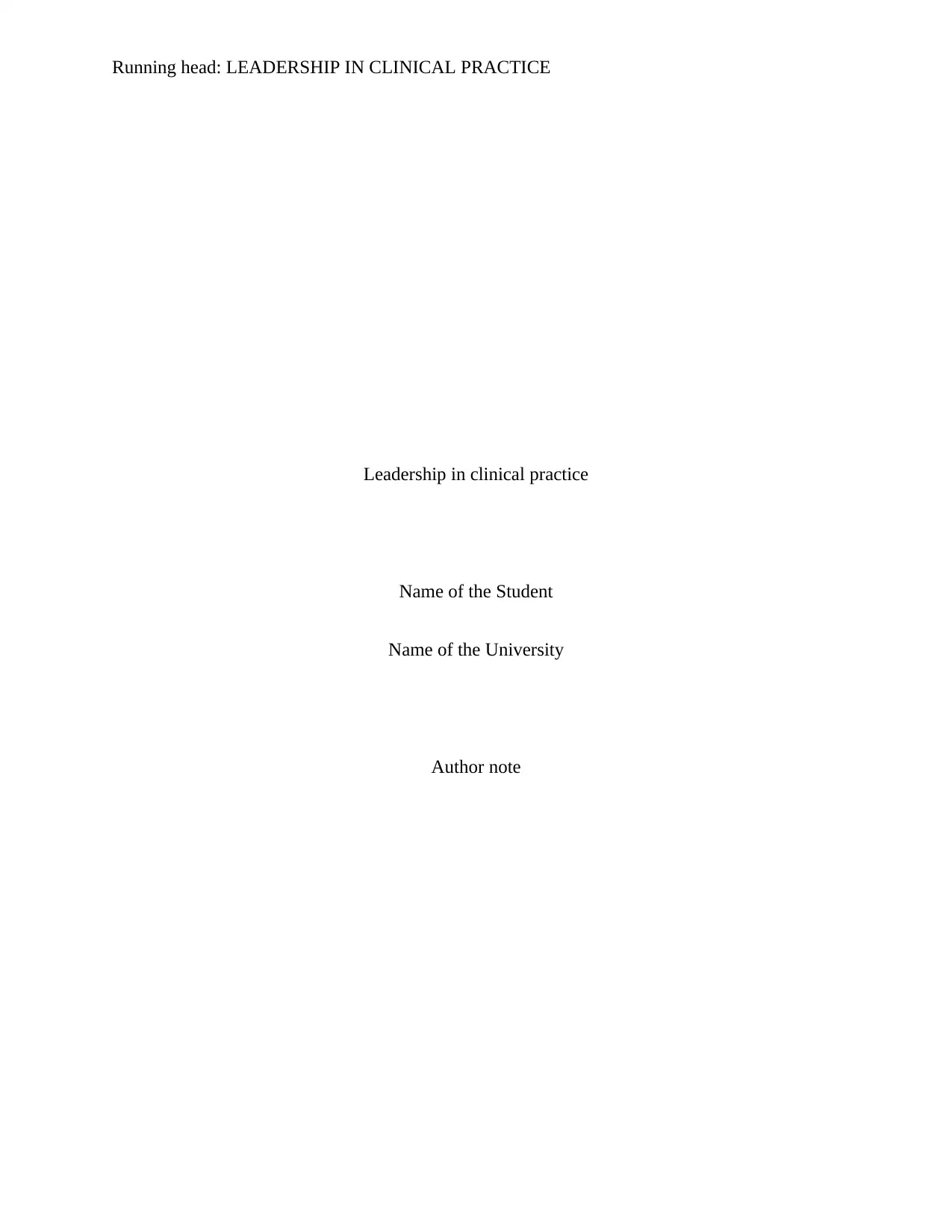
Running head: LEADERSHIP IN CLINICAL PRACTICE
Leadership in clinical practice
Name of the Student
Name of the University
Author note
Leadership in clinical practice
Name of the Student
Name of the University
Author note
Paraphrase This Document
Need a fresh take? Get an instant paraphrase of this document with our AI Paraphraser
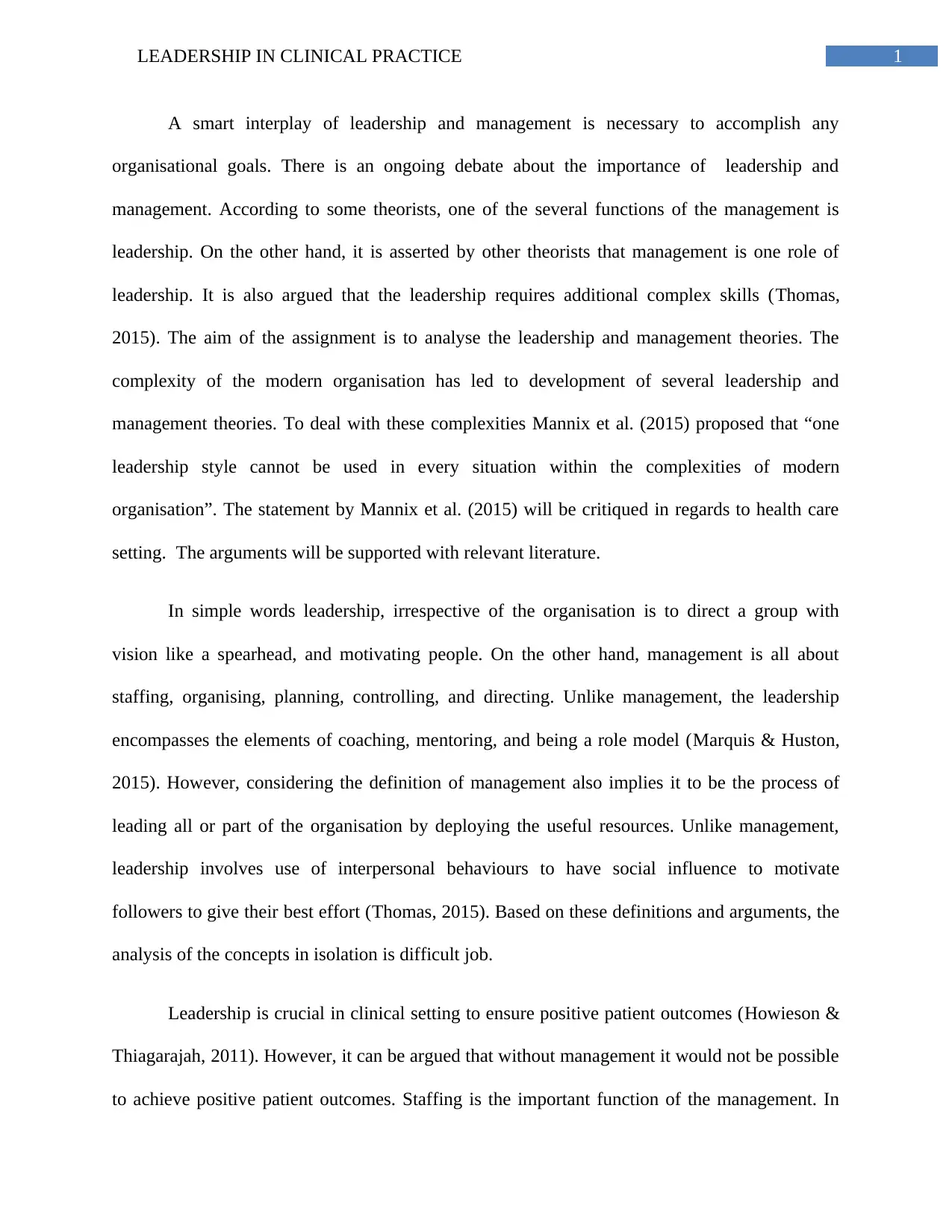
1LEADERSHIP IN CLINICAL PRACTICE
A smart interplay of leadership and management is necessary to accomplish any
organisational goals. There is an ongoing debate about the importance of leadership and
management. According to some theorists, one of the several functions of the management is
leadership. On the other hand, it is asserted by other theorists that management is one role of
leadership. It is also argued that the leadership requires additional complex skills (Thomas,
2015). The aim of the assignment is to analyse the leadership and management theories. The
complexity of the modern organisation has led to development of several leadership and
management theories. To deal with these complexities Mannix et al. (2015) proposed that “one
leadership style cannot be used in every situation within the complexities of modern
organisation”. The statement by Mannix et al. (2015) will be critiqued in regards to health care
setting. The arguments will be supported with relevant literature.
In simple words leadership, irrespective of the organisation is to direct a group with
vision like a spearhead, and motivating people. On the other hand, management is all about
staffing, organising, planning, controlling, and directing. Unlike management, the leadership
encompasses the elements of coaching, mentoring, and being a role model (Marquis & Huston,
2015). However, considering the definition of management also implies it to be the process of
leading all or part of the organisation by deploying the useful resources. Unlike management,
leadership involves use of interpersonal behaviours to have social influence to motivate
followers to give their best effort (Thomas, 2015). Based on these definitions and arguments, the
analysis of the concepts in isolation is difficult job.
Leadership is crucial in clinical setting to ensure positive patient outcomes (Howieson &
Thiagarajah, 2011). However, it can be argued that without management it would not be possible
to achieve positive patient outcomes. Staffing is the important function of the management. In
A smart interplay of leadership and management is necessary to accomplish any
organisational goals. There is an ongoing debate about the importance of leadership and
management. According to some theorists, one of the several functions of the management is
leadership. On the other hand, it is asserted by other theorists that management is one role of
leadership. It is also argued that the leadership requires additional complex skills (Thomas,
2015). The aim of the assignment is to analyse the leadership and management theories. The
complexity of the modern organisation has led to development of several leadership and
management theories. To deal with these complexities Mannix et al. (2015) proposed that “one
leadership style cannot be used in every situation within the complexities of modern
organisation”. The statement by Mannix et al. (2015) will be critiqued in regards to health care
setting. The arguments will be supported with relevant literature.
In simple words leadership, irrespective of the organisation is to direct a group with
vision like a spearhead, and motivating people. On the other hand, management is all about
staffing, organising, planning, controlling, and directing. Unlike management, the leadership
encompasses the elements of coaching, mentoring, and being a role model (Marquis & Huston,
2015). However, considering the definition of management also implies it to be the process of
leading all or part of the organisation by deploying the useful resources. Unlike management,
leadership involves use of interpersonal behaviours to have social influence to motivate
followers to give their best effort (Thomas, 2015). Based on these definitions and arguments, the
analysis of the concepts in isolation is difficult job.
Leadership is crucial in clinical setting to ensure positive patient outcomes (Howieson &
Thiagarajah, 2011). However, it can be argued that without management it would not be possible
to achieve positive patient outcomes. Staffing is the important function of the management. In
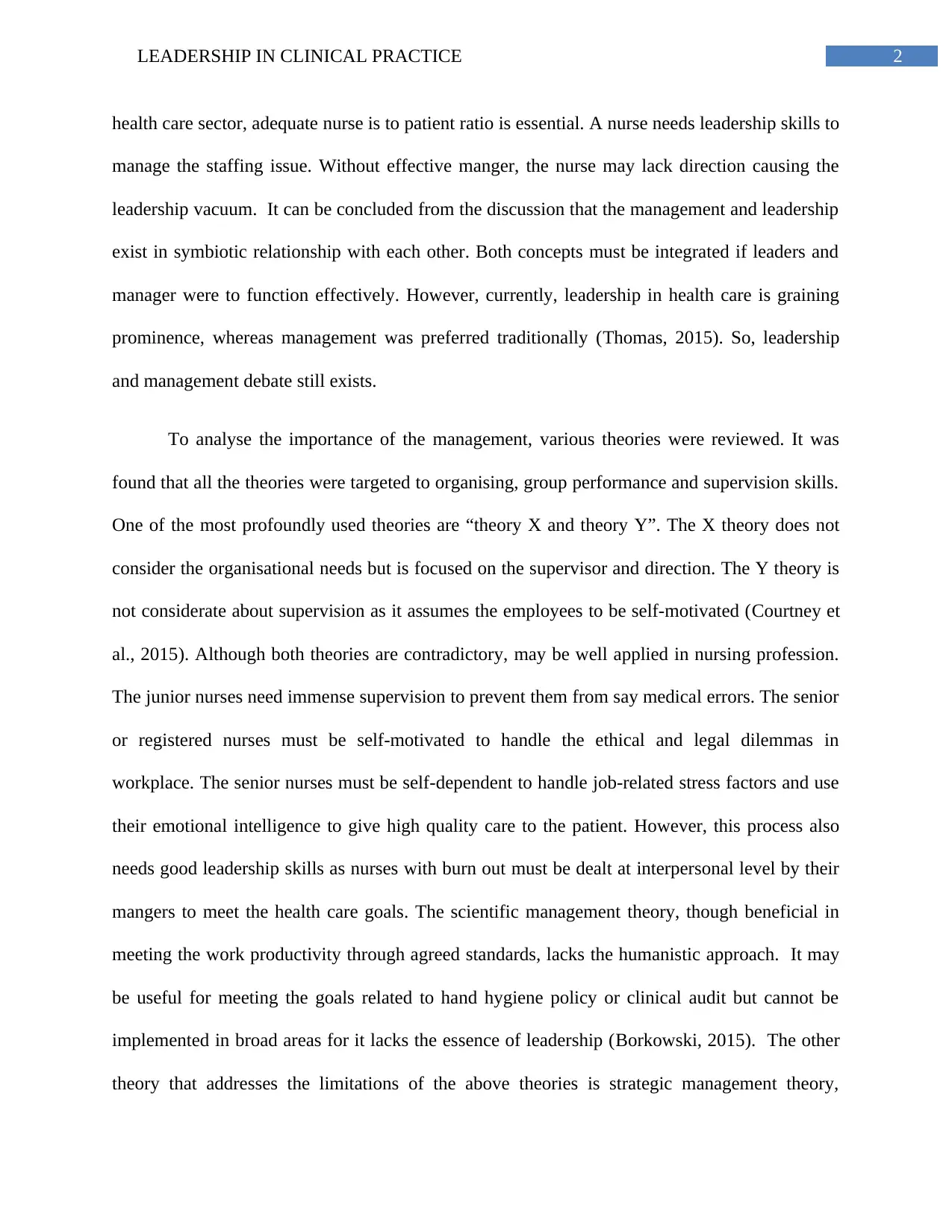
2LEADERSHIP IN CLINICAL PRACTICE
health care sector, adequate nurse is to patient ratio is essential. A nurse needs leadership skills to
manage the staffing issue. Without effective manger, the nurse may lack direction causing the
leadership vacuum. It can be concluded from the discussion that the management and leadership
exist in symbiotic relationship with each other. Both concepts must be integrated if leaders and
manager were to function effectively. However, currently, leadership in health care is graining
prominence, whereas management was preferred traditionally (Thomas, 2015). So, leadership
and management debate still exists.
To analyse the importance of the management, various theories were reviewed. It was
found that all the theories were targeted to organising, group performance and supervision skills.
One of the most profoundly used theories are “theory X and theory Y”. The X theory does not
consider the organisational needs but is focused on the supervisor and direction. The Y theory is
not considerate about supervision as it assumes the employees to be self-motivated (Courtney et
al., 2015). Although both theories are contradictory, may be well applied in nursing profession.
The junior nurses need immense supervision to prevent them from say medical errors. The senior
or registered nurses must be self-motivated to handle the ethical and legal dilemmas in
workplace. The senior nurses must be self-dependent to handle job-related stress factors and use
their emotional intelligence to give high quality care to the patient. However, this process also
needs good leadership skills as nurses with burn out must be dealt at interpersonal level by their
mangers to meet the health care goals. The scientific management theory, though beneficial in
meeting the work productivity through agreed standards, lacks the humanistic approach. It may
be useful for meeting the goals related to hand hygiene policy or clinical audit but cannot be
implemented in broad areas for it lacks the essence of leadership (Borkowski, 2015). The other
theory that addresses the limitations of the above theories is strategic management theory,
health care sector, adequate nurse is to patient ratio is essential. A nurse needs leadership skills to
manage the staffing issue. Without effective manger, the nurse may lack direction causing the
leadership vacuum. It can be concluded from the discussion that the management and leadership
exist in symbiotic relationship with each other. Both concepts must be integrated if leaders and
manager were to function effectively. However, currently, leadership in health care is graining
prominence, whereas management was preferred traditionally (Thomas, 2015). So, leadership
and management debate still exists.
To analyse the importance of the management, various theories were reviewed. It was
found that all the theories were targeted to organising, group performance and supervision skills.
One of the most profoundly used theories are “theory X and theory Y”. The X theory does not
consider the organisational needs but is focused on the supervisor and direction. The Y theory is
not considerate about supervision as it assumes the employees to be self-motivated (Courtney et
al., 2015). Although both theories are contradictory, may be well applied in nursing profession.
The junior nurses need immense supervision to prevent them from say medical errors. The senior
or registered nurses must be self-motivated to handle the ethical and legal dilemmas in
workplace. The senior nurses must be self-dependent to handle job-related stress factors and use
their emotional intelligence to give high quality care to the patient. However, this process also
needs good leadership skills as nurses with burn out must be dealt at interpersonal level by their
mangers to meet the health care goals. The scientific management theory, though beneficial in
meeting the work productivity through agreed standards, lacks the humanistic approach. It may
be useful for meeting the goals related to hand hygiene policy or clinical audit but cannot be
implemented in broad areas for it lacks the essence of leadership (Borkowski, 2015). The other
theory that addresses the limitations of the above theories is strategic management theory,
⊘ This is a preview!⊘
Do you want full access?
Subscribe today to unlock all pages.

Trusted by 1+ million students worldwide
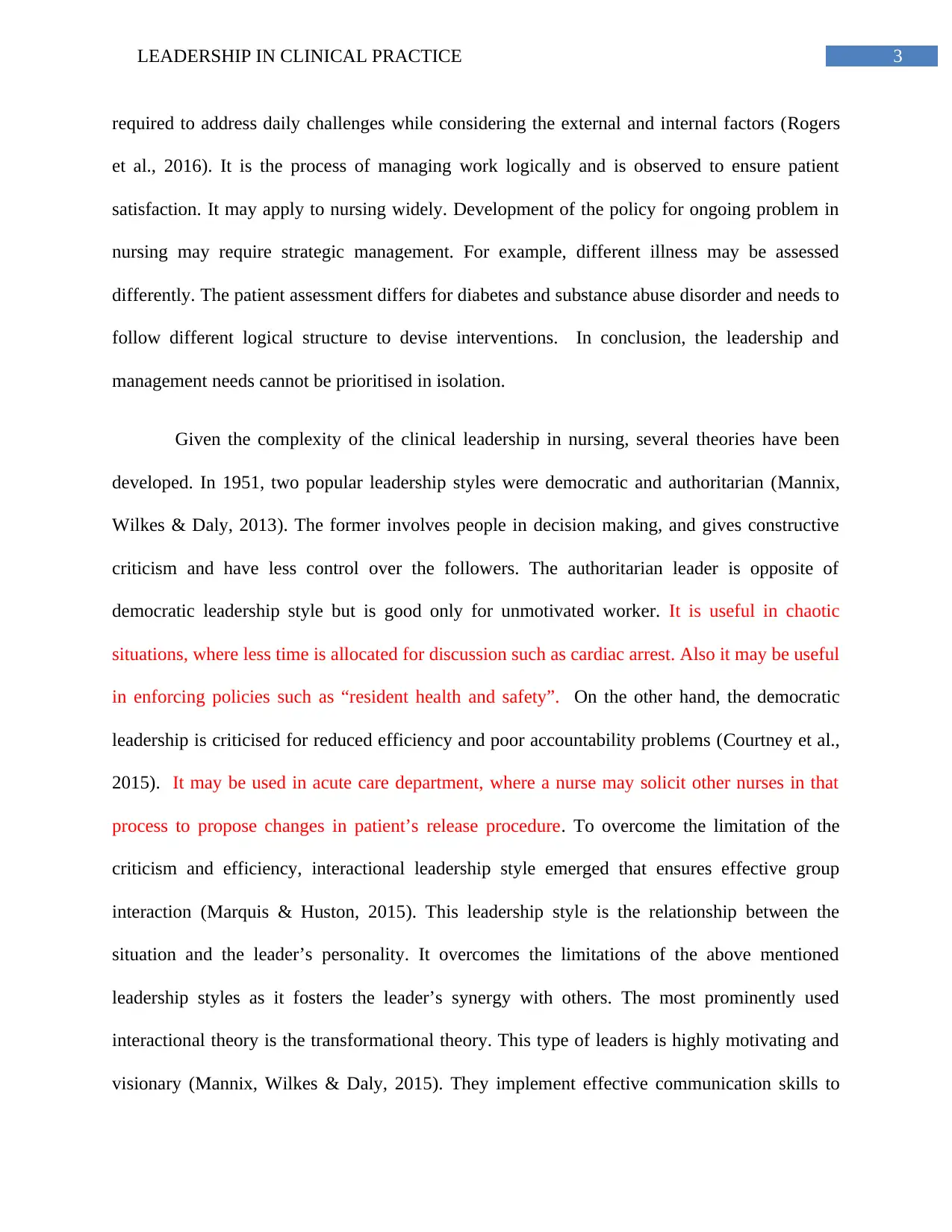
3LEADERSHIP IN CLINICAL PRACTICE
required to address daily challenges while considering the external and internal factors (Rogers
et al., 2016). It is the process of managing work logically and is observed to ensure patient
satisfaction. It may apply to nursing widely. Development of the policy for ongoing problem in
nursing may require strategic management. For example, different illness may be assessed
differently. The patient assessment differs for diabetes and substance abuse disorder and needs to
follow different logical structure to devise interventions. In conclusion, the leadership and
management needs cannot be prioritised in isolation.
Given the complexity of the clinical leadership in nursing, several theories have been
developed. In 1951, two popular leadership styles were democratic and authoritarian (Mannix,
Wilkes & Daly, 2013). The former involves people in decision making, and gives constructive
criticism and have less control over the followers. The authoritarian leader is opposite of
democratic leadership style but is good only for unmotivated worker. It is useful in chaotic
situations, where less time is allocated for discussion such as cardiac arrest. Also it may be useful
in enforcing policies such as “resident health and safety”. On the other hand, the democratic
leadership is criticised for reduced efficiency and poor accountability problems (Courtney et al.,
2015). It may be used in acute care department, where a nurse may solicit other nurses in that
process to propose changes in patient’s release procedure. To overcome the limitation of the
criticism and efficiency, interactional leadership style emerged that ensures effective group
interaction (Marquis & Huston, 2015). This leadership style is the relationship between the
situation and the leader’s personality. It overcomes the limitations of the above mentioned
leadership styles as it fosters the leader’s synergy with others. The most prominently used
interactional theory is the transformational theory. This type of leaders is highly motivating and
visionary (Mannix, Wilkes & Daly, 2015). They implement effective communication skills to
required to address daily challenges while considering the external and internal factors (Rogers
et al., 2016). It is the process of managing work logically and is observed to ensure patient
satisfaction. It may apply to nursing widely. Development of the policy for ongoing problem in
nursing may require strategic management. For example, different illness may be assessed
differently. The patient assessment differs for diabetes and substance abuse disorder and needs to
follow different logical structure to devise interventions. In conclusion, the leadership and
management needs cannot be prioritised in isolation.
Given the complexity of the clinical leadership in nursing, several theories have been
developed. In 1951, two popular leadership styles were democratic and authoritarian (Mannix,
Wilkes & Daly, 2013). The former involves people in decision making, and gives constructive
criticism and have less control over the followers. The authoritarian leader is opposite of
democratic leadership style but is good only for unmotivated worker. It is useful in chaotic
situations, where less time is allocated for discussion such as cardiac arrest. Also it may be useful
in enforcing policies such as “resident health and safety”. On the other hand, the democratic
leadership is criticised for reduced efficiency and poor accountability problems (Courtney et al.,
2015). It may be used in acute care department, where a nurse may solicit other nurses in that
process to propose changes in patient’s release procedure. To overcome the limitation of the
criticism and efficiency, interactional leadership style emerged that ensures effective group
interaction (Marquis & Huston, 2015). This leadership style is the relationship between the
situation and the leader’s personality. It overcomes the limitations of the above mentioned
leadership styles as it fosters the leader’s synergy with others. The most prominently used
interactional theory is the transformational theory. This type of leaders is highly motivating and
visionary (Mannix, Wilkes & Daly, 2015). They implement effective communication skills to
Paraphrase This Document
Need a fresh take? Get an instant paraphrase of this document with our AI Paraphraser
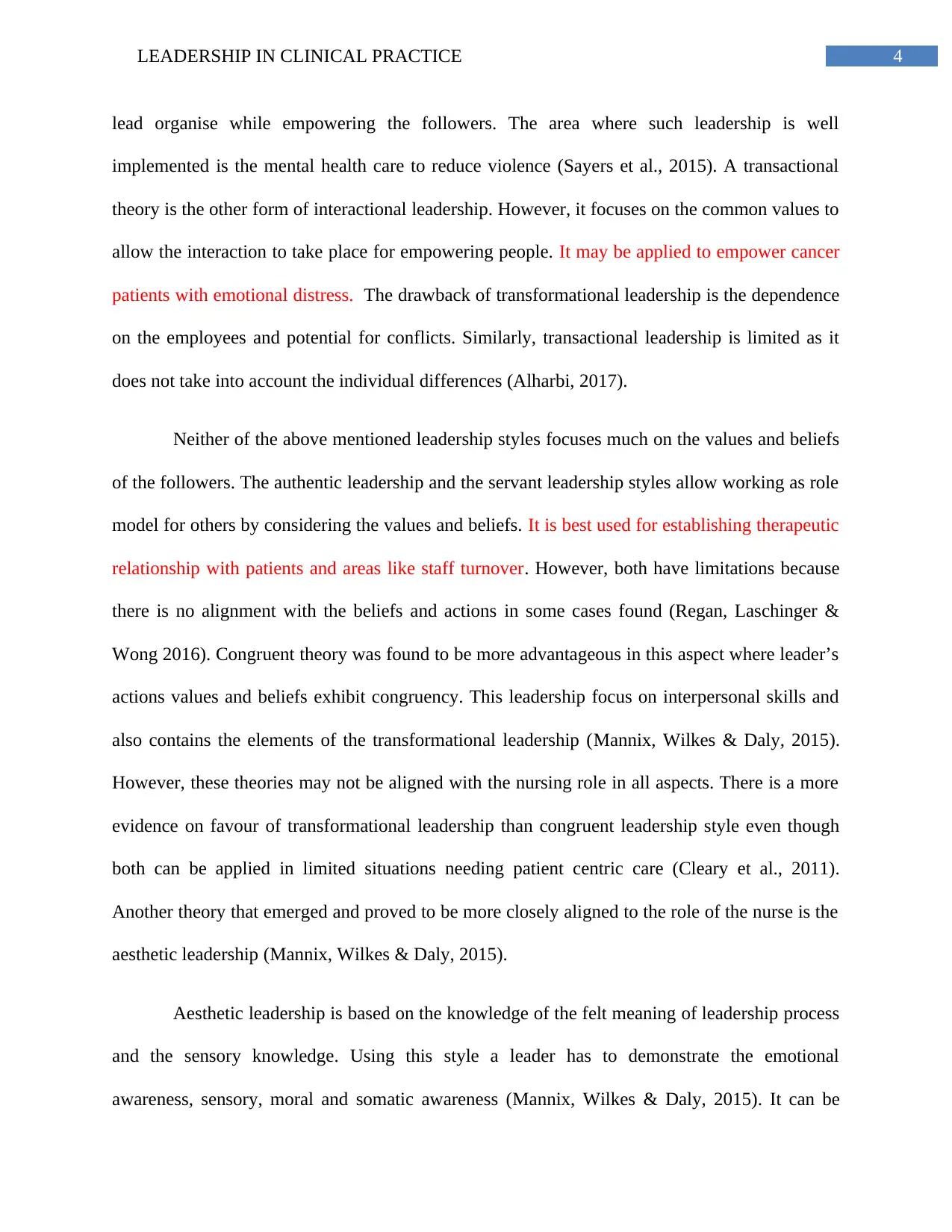
4LEADERSHIP IN CLINICAL PRACTICE
lead organise while empowering the followers. The area where such leadership is well
implemented is the mental health care to reduce violence (Sayers et al., 2015). A transactional
theory is the other form of interactional leadership. However, it focuses on the common values to
allow the interaction to take place for empowering people. It may be applied to empower cancer
patients with emotional distress. The drawback of transformational leadership is the dependence
on the employees and potential for conflicts. Similarly, transactional leadership is limited as it
does not take into account the individual differences (Alharbi, 2017).
Neither of the above mentioned leadership styles focuses much on the values and beliefs
of the followers. The authentic leadership and the servant leadership styles allow working as role
model for others by considering the values and beliefs. It is best used for establishing therapeutic
relationship with patients and areas like staff turnover. However, both have limitations because
there is no alignment with the beliefs and actions in some cases found (Regan, Laschinger &
Wong 2016). Congruent theory was found to be more advantageous in this aspect where leader’s
actions values and beliefs exhibit congruency. This leadership focus on interpersonal skills and
also contains the elements of the transformational leadership (Mannix, Wilkes & Daly, 2015).
However, these theories may not be aligned with the nursing role in all aspects. There is a more
evidence on favour of transformational leadership than congruent leadership style even though
both can be applied in limited situations needing patient centric care (Cleary et al., 2011).
Another theory that emerged and proved to be more closely aligned to the role of the nurse is the
aesthetic leadership (Mannix, Wilkes & Daly, 2015).
Aesthetic leadership is based on the knowledge of the felt meaning of leadership process
and the sensory knowledge. Using this style a leader has to demonstrate the emotional
awareness, sensory, moral and somatic awareness (Mannix, Wilkes & Daly, 2015). It can be
lead organise while empowering the followers. The area where such leadership is well
implemented is the mental health care to reduce violence (Sayers et al., 2015). A transactional
theory is the other form of interactional leadership. However, it focuses on the common values to
allow the interaction to take place for empowering people. It may be applied to empower cancer
patients with emotional distress. The drawback of transformational leadership is the dependence
on the employees and potential for conflicts. Similarly, transactional leadership is limited as it
does not take into account the individual differences (Alharbi, 2017).
Neither of the above mentioned leadership styles focuses much on the values and beliefs
of the followers. The authentic leadership and the servant leadership styles allow working as role
model for others by considering the values and beliefs. It is best used for establishing therapeutic
relationship with patients and areas like staff turnover. However, both have limitations because
there is no alignment with the beliefs and actions in some cases found (Regan, Laschinger &
Wong 2016). Congruent theory was found to be more advantageous in this aspect where leader’s
actions values and beliefs exhibit congruency. This leadership focus on interpersonal skills and
also contains the elements of the transformational leadership (Mannix, Wilkes & Daly, 2015).
However, these theories may not be aligned with the nursing role in all aspects. There is a more
evidence on favour of transformational leadership than congruent leadership style even though
both can be applied in limited situations needing patient centric care (Cleary et al., 2011).
Another theory that emerged and proved to be more closely aligned to the role of the nurse is the
aesthetic leadership (Mannix, Wilkes & Daly, 2015).
Aesthetic leadership is based on the knowledge of the felt meaning of leadership process
and the sensory knowledge. Using this style a leader has to demonstrate the emotional
awareness, sensory, moral and somatic awareness (Mannix, Wilkes & Daly, 2015). It can be
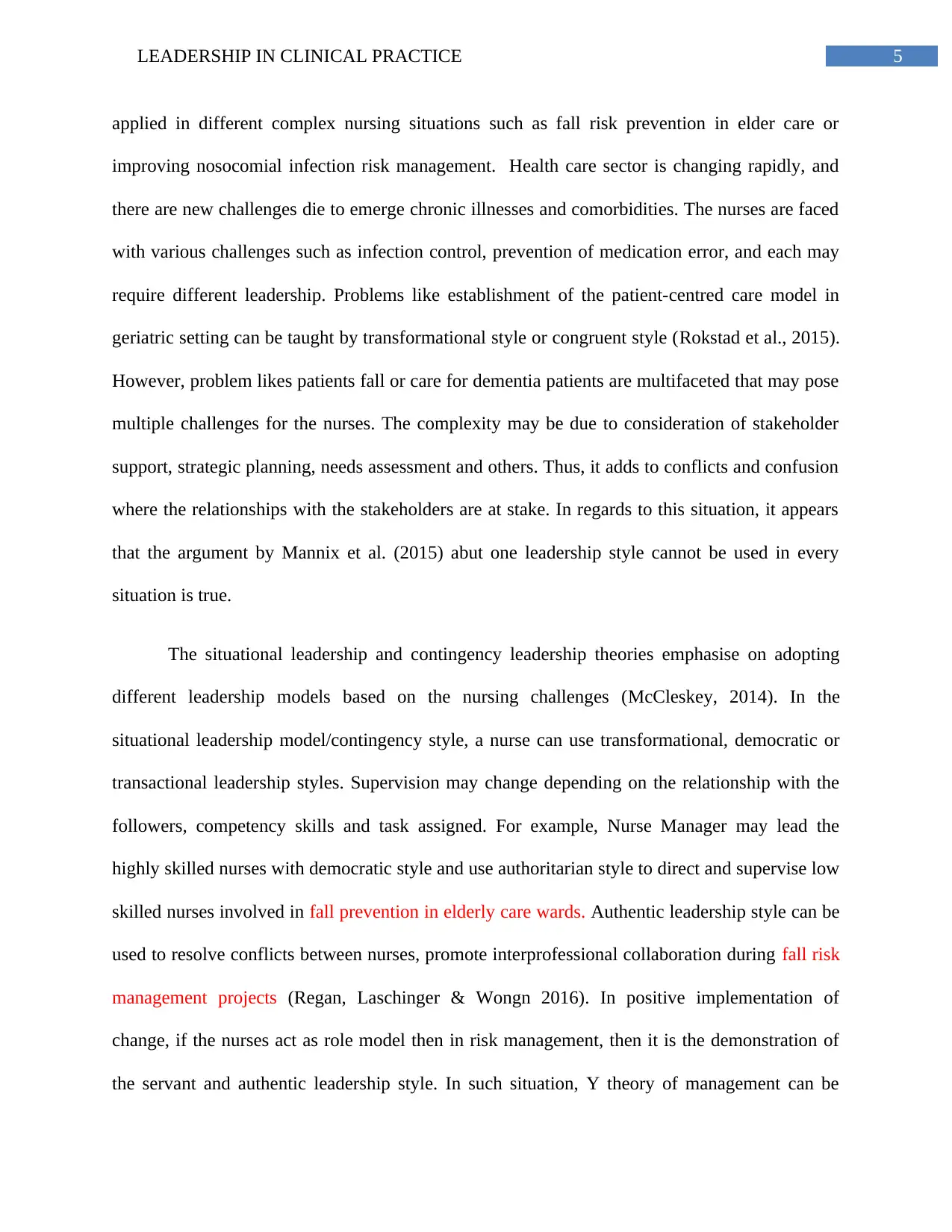
5LEADERSHIP IN CLINICAL PRACTICE
applied in different complex nursing situations such as fall risk prevention in elder care or
improving nosocomial infection risk management. Health care sector is changing rapidly, and
there are new challenges die to emerge chronic illnesses and comorbidities. The nurses are faced
with various challenges such as infection control, prevention of medication error, and each may
require different leadership. Problems like establishment of the patient-centred care model in
geriatric setting can be taught by transformational style or congruent style (Rokstad et al., 2015).
However, problem likes patients fall or care for dementia patients are multifaceted that may pose
multiple challenges for the nurses. The complexity may be due to consideration of stakeholder
support, strategic planning, needs assessment and others. Thus, it adds to conflicts and confusion
where the relationships with the stakeholders are at stake. In regards to this situation, it appears
that the argument by Mannix et al. (2015) abut one leadership style cannot be used in every
situation is true.
The situational leadership and contingency leadership theories emphasise on adopting
different leadership models based on the nursing challenges (McCleskey, 2014). In the
situational leadership model/contingency style, a nurse can use transformational, democratic or
transactional leadership styles. Supervision may change depending on the relationship with the
followers, competency skills and task assigned. For example, Nurse Manager may lead the
highly skilled nurses with democratic style and use authoritarian style to direct and supervise low
skilled nurses involved in fall prevention in elderly care wards. Authentic leadership style can be
used to resolve conflicts between nurses, promote interprofessional collaboration during fall risk
management projects (Regan, Laschinger & Wongn 2016). In positive implementation of
change, if the nurses act as role model then in risk management, then it is the demonstration of
the servant and authentic leadership style. In such situation, Y theory of management can be
applied in different complex nursing situations such as fall risk prevention in elder care or
improving nosocomial infection risk management. Health care sector is changing rapidly, and
there are new challenges die to emerge chronic illnesses and comorbidities. The nurses are faced
with various challenges such as infection control, prevention of medication error, and each may
require different leadership. Problems like establishment of the patient-centred care model in
geriatric setting can be taught by transformational style or congruent style (Rokstad et al., 2015).
However, problem likes patients fall or care for dementia patients are multifaceted that may pose
multiple challenges for the nurses. The complexity may be due to consideration of stakeholder
support, strategic planning, needs assessment and others. Thus, it adds to conflicts and confusion
where the relationships with the stakeholders are at stake. In regards to this situation, it appears
that the argument by Mannix et al. (2015) abut one leadership style cannot be used in every
situation is true.
The situational leadership and contingency leadership theories emphasise on adopting
different leadership models based on the nursing challenges (McCleskey, 2014). In the
situational leadership model/contingency style, a nurse can use transformational, democratic or
transactional leadership styles. Supervision may change depending on the relationship with the
followers, competency skills and task assigned. For example, Nurse Manager may lead the
highly skilled nurses with democratic style and use authoritarian style to direct and supervise low
skilled nurses involved in fall prevention in elderly care wards. Authentic leadership style can be
used to resolve conflicts between nurses, promote interprofessional collaboration during fall risk
management projects (Regan, Laschinger & Wongn 2016). In positive implementation of
change, if the nurses act as role model then in risk management, then it is the demonstration of
the servant and authentic leadership style. In such situation, Y theory of management can be
⊘ This is a preview!⊘
Do you want full access?
Subscribe today to unlock all pages.

Trusted by 1+ million students worldwide
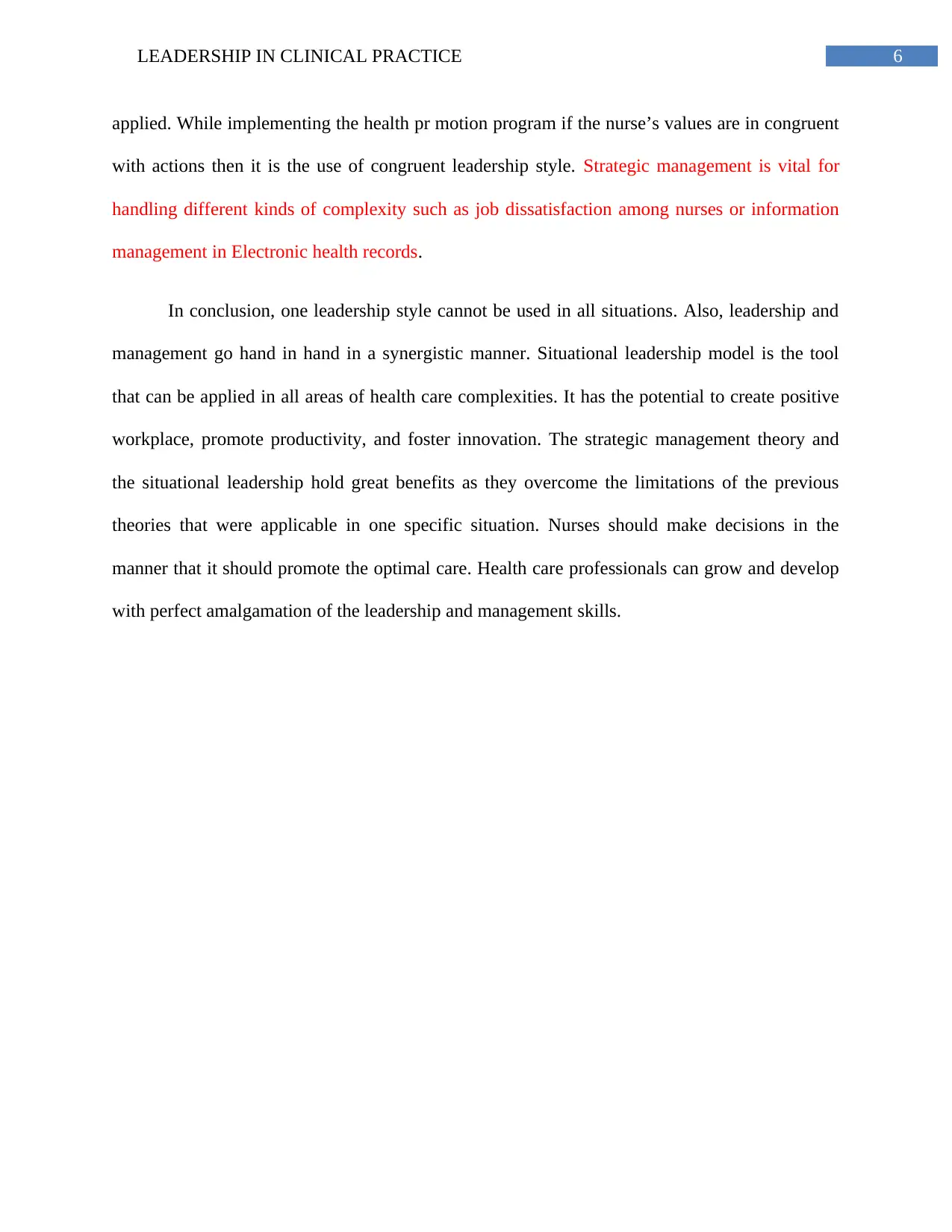
6LEADERSHIP IN CLINICAL PRACTICE
applied. While implementing the health pr motion program if the nurse’s values are in congruent
with actions then it is the use of congruent leadership style. Strategic management is vital for
handling different kinds of complexity such as job dissatisfaction among nurses or information
management in Electronic health records.
In conclusion, one leadership style cannot be used in all situations. Also, leadership and
management go hand in hand in a synergistic manner. Situational leadership model is the tool
that can be applied in all areas of health care complexities. It has the potential to create positive
workplace, promote productivity, and foster innovation. The strategic management theory and
the situational leadership hold great benefits as they overcome the limitations of the previous
theories that were applicable in one specific situation. Nurses should make decisions in the
manner that it should promote the optimal care. Health care professionals can grow and develop
with perfect amalgamation of the leadership and management skills.
applied. While implementing the health pr motion program if the nurse’s values are in congruent
with actions then it is the use of congruent leadership style. Strategic management is vital for
handling different kinds of complexity such as job dissatisfaction among nurses or information
management in Electronic health records.
In conclusion, one leadership style cannot be used in all situations. Also, leadership and
management go hand in hand in a synergistic manner. Situational leadership model is the tool
that can be applied in all areas of health care complexities. It has the potential to create positive
workplace, promote productivity, and foster innovation. The strategic management theory and
the situational leadership hold great benefits as they overcome the limitations of the previous
theories that were applicable in one specific situation. Nurses should make decisions in the
manner that it should promote the optimal care. Health care professionals can grow and develop
with perfect amalgamation of the leadership and management skills.
Paraphrase This Document
Need a fresh take? Get an instant paraphrase of this document with our AI Paraphraser
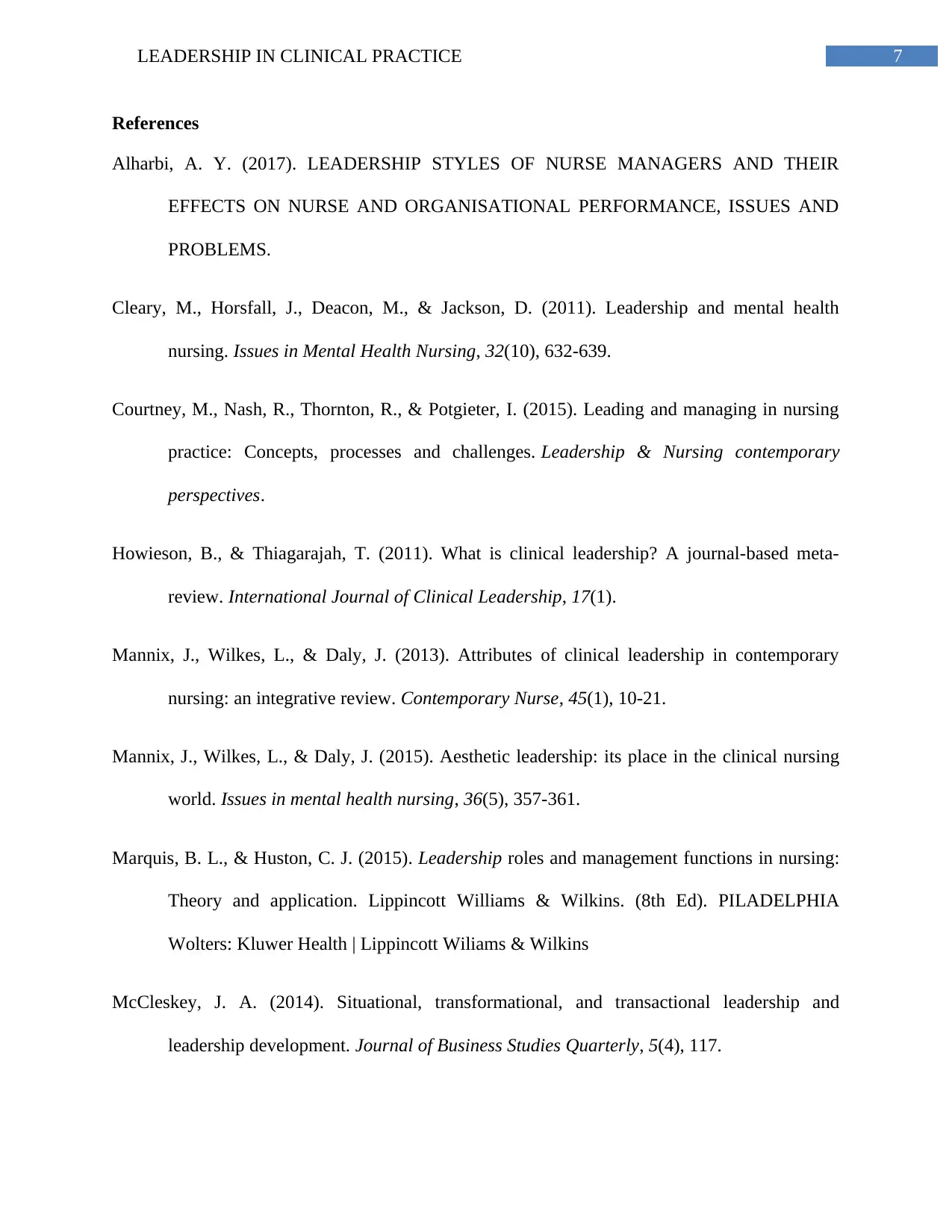
7LEADERSHIP IN CLINICAL PRACTICE
References
Alharbi, A. Y. (2017). LEADERSHIP STYLES OF NURSE MANAGERS AND THEIR
EFFECTS ON NURSE AND ORGANISATIONAL PERFORMANCE, ISSUES AND
PROBLEMS.
Cleary, M., Horsfall, J., Deacon, M., & Jackson, D. (2011). Leadership and mental health
nursing. Issues in Mental Health Nursing, 32(10), 632-639.
Courtney, M., Nash, R., Thornton, R., & Potgieter, I. (2015). Leading and managing in nursing
practice: Concepts, processes and challenges. Leadership & Nursing contemporary
perspectives.
Howieson, B., & Thiagarajah, T. (2011). What is clinical leadership? A journal-based meta-
review. International Journal of Clinical Leadership, 17(1).
Mannix, J., Wilkes, L., & Daly, J. (2013). Attributes of clinical leadership in contemporary
nursing: an integrative review. Contemporary Nurse, 45(1), 10-21.
Mannix, J., Wilkes, L., & Daly, J. (2015). Aesthetic leadership: its place in the clinical nursing
world. Issues in mental health nursing, 36(5), 357-361.
Marquis, B. L., & Huston, C. J. (2015). Leadership roles and management functions in nursing:
Theory and application. Lippincott Williams & Wilkins. (8th Ed). PILADELPHIA
Wolters: Kluwer Health | Lippincott Wiliams & Wilkins
McCleskey, J. A. (2014). Situational, transformational, and transactional leadership and
leadership development. Journal of Business Studies Quarterly, 5(4), 117.
References
Alharbi, A. Y. (2017). LEADERSHIP STYLES OF NURSE MANAGERS AND THEIR
EFFECTS ON NURSE AND ORGANISATIONAL PERFORMANCE, ISSUES AND
PROBLEMS.
Cleary, M., Horsfall, J., Deacon, M., & Jackson, D. (2011). Leadership and mental health
nursing. Issues in Mental Health Nursing, 32(10), 632-639.
Courtney, M., Nash, R., Thornton, R., & Potgieter, I. (2015). Leading and managing in nursing
practice: Concepts, processes and challenges. Leadership & Nursing contemporary
perspectives.
Howieson, B., & Thiagarajah, T. (2011). What is clinical leadership? A journal-based meta-
review. International Journal of Clinical Leadership, 17(1).
Mannix, J., Wilkes, L., & Daly, J. (2013). Attributes of clinical leadership in contemporary
nursing: an integrative review. Contemporary Nurse, 45(1), 10-21.
Mannix, J., Wilkes, L., & Daly, J. (2015). Aesthetic leadership: its place in the clinical nursing
world. Issues in mental health nursing, 36(5), 357-361.
Marquis, B. L., & Huston, C. J. (2015). Leadership roles and management functions in nursing:
Theory and application. Lippincott Williams & Wilkins. (8th Ed). PILADELPHIA
Wolters: Kluwer Health | Lippincott Wiliams & Wilkins
McCleskey, J. A. (2014). Situational, transformational, and transactional leadership and
leadership development. Journal of Business Studies Quarterly, 5(4), 117.
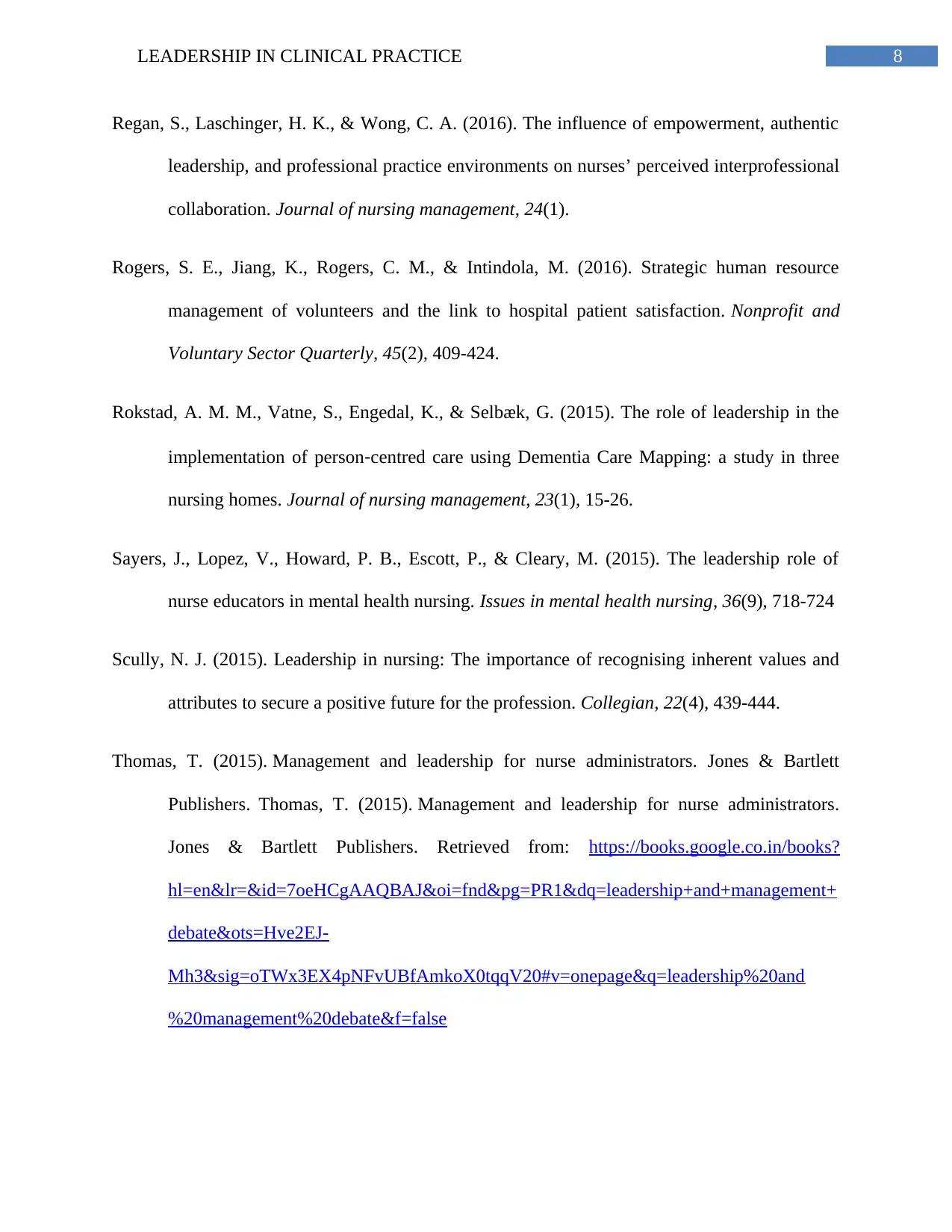
8LEADERSHIP IN CLINICAL PRACTICE
Regan, S., Laschinger, H. K., & Wong, C. A. (2016). The influence of empowerment, authentic
leadership, and professional practice environments on nurses’ perceived interprofessional
collaboration. Journal of nursing management, 24(1).
Rogers, S. E., Jiang, K., Rogers, C. M., & Intindola, M. (2016). Strategic human resource
management of volunteers and the link to hospital patient satisfaction. Nonprofit and
Voluntary Sector Quarterly, 45(2), 409-424.
Rokstad, A. M. M., Vatne, S., Engedal, K., & Selbæk, G. (2015). The role of leadership in the
implementation of person‐centred care using Dementia Care Mapping: a study in three
nursing homes. Journal of nursing management, 23(1), 15-26.
Sayers, J., Lopez, V., Howard, P. B., Escott, P., & Cleary, M. (2015). The leadership role of
nurse educators in mental health nursing. Issues in mental health nursing, 36(9), 718-724
Scully, N. J. (2015). Leadership in nursing: The importance of recognising inherent values and
attributes to secure a positive future for the profession. Collegian, 22(4), 439-444.
Thomas, T. (2015). Management and leadership for nurse administrators. Jones & Bartlett
Publishers. Thomas, T. (2015). Management and leadership for nurse administrators.
Jones & Bartlett Publishers. Retrieved from: https://books.google.co.in/books?
hl=en&lr=&id=7oeHCgAAQBAJ&oi=fnd&pg=PR1&dq=leadership+and+management+
debate&ots=Hve2EJ-
Mh3&sig=oTWx3EX4pNFvUBfAmkoX0tqqV20#v=onepage&q=leadership%20and
%20management%20debate&f=false
Regan, S., Laschinger, H. K., & Wong, C. A. (2016). The influence of empowerment, authentic
leadership, and professional practice environments on nurses’ perceived interprofessional
collaboration. Journal of nursing management, 24(1).
Rogers, S. E., Jiang, K., Rogers, C. M., & Intindola, M. (2016). Strategic human resource
management of volunteers and the link to hospital patient satisfaction. Nonprofit and
Voluntary Sector Quarterly, 45(2), 409-424.
Rokstad, A. M. M., Vatne, S., Engedal, K., & Selbæk, G. (2015). The role of leadership in the
implementation of person‐centred care using Dementia Care Mapping: a study in three
nursing homes. Journal of nursing management, 23(1), 15-26.
Sayers, J., Lopez, V., Howard, P. B., Escott, P., & Cleary, M. (2015). The leadership role of
nurse educators in mental health nursing. Issues in mental health nursing, 36(9), 718-724
Scully, N. J. (2015). Leadership in nursing: The importance of recognising inherent values and
attributes to secure a positive future for the profession. Collegian, 22(4), 439-444.
Thomas, T. (2015). Management and leadership for nurse administrators. Jones & Bartlett
Publishers. Thomas, T. (2015). Management and leadership for nurse administrators.
Jones & Bartlett Publishers. Retrieved from: https://books.google.co.in/books?
hl=en&lr=&id=7oeHCgAAQBAJ&oi=fnd&pg=PR1&dq=leadership+and+management+
debate&ots=Hve2EJ-
Mh3&sig=oTWx3EX4pNFvUBfAmkoX0tqqV20#v=onepage&q=leadership%20and
%20management%20debate&f=false
⊘ This is a preview!⊘
Do you want full access?
Subscribe today to unlock all pages.

Trusted by 1+ million students worldwide

9LEADERSHIP IN CLINICAL PRACTICE
Borkowski, N. (2015). Organizational behavior, theory, and design in health care. Jones &
Bartlett Publishers.
Borkowski, N. (2015). Organizational behavior, theory, and design in health care. Jones &
Bartlett Publishers.
1 out of 10
Related Documents
Your All-in-One AI-Powered Toolkit for Academic Success.
+13062052269
info@desklib.com
Available 24*7 on WhatsApp / Email
![[object Object]](/_next/static/media/star-bottom.7253800d.svg)
Unlock your academic potential
Copyright © 2020–2025 A2Z Services. All Rights Reserved. Developed and managed by ZUCOL.





